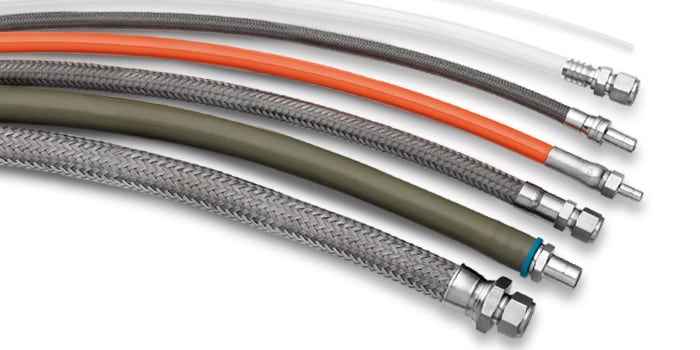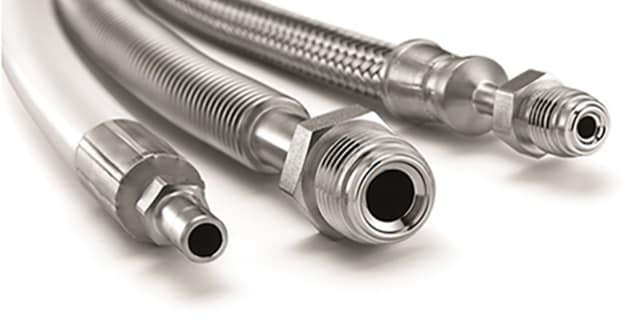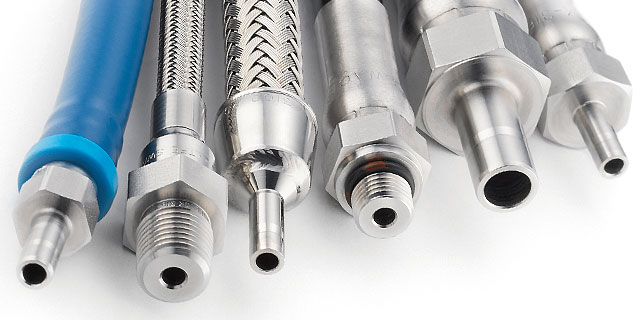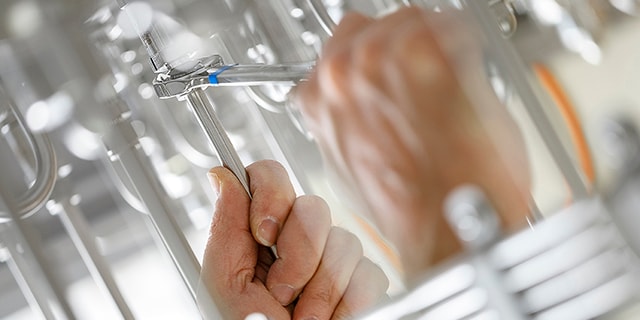Industrial Hose Material: Core Tube Considerations

Industrial Hose Replacement: Core Tube Material Considerations
Doug Nordstrom, Senior Product Manager, Hose Product Group
The right industrial hose keeps your fluid systems performing safely and effectively. The wrong hose, however, can undermine your processes, put your personnel at risk, and compromise your bottom line. All too often, engineers are not even aware their hoses are an issue until it’s too late.
Despite its importance, hose selection is often treated as an afterthought. The right industrial hose is more valuable than its purchase price. Proper selection requires close attention to the variables with your application such as temperature, chemical compatibility, drainability, and pressure and flow requirements.
Read on to learn more on the unique materials within the core tube—an industrial hose’s innermost layer—and how to select a proper hose based on its core.
Questions to Consider Before Selecting Your Core Tube Material
Below are basic questions to consider prior to selecting your core tube material. You can address these questions with the help of manufacturer product catalogs or with your Swagelok sales and service representative.
- Is the core material chemically compatible with the system media? Will it corrode or deteriorate over time?
- Can the core material tolerate the temperature range of the system media?
- Will the core tube material prevent or limit permeation and absorption? (Depending on your application, permeation and/or absorption may not be an issue.)
- Will the core material withstand your system’s cleaning practices? This includes temperature, pressure and material compatibility with any solvents and cleaning agents.
Types of Core Tube Materials
Metal
Pros
Metal cores (commonly 316L stainless steel) are a good choice for general fluid system needs. They are usually rated for temperatures between –325°F and 850°F or higher (–200°C and 454°C), making metal core tubes an exceptionally good choice for system media at extreme temperatures. Metal flexible tubing is also a good choice when there is little allowance for permeation or absorption.
Cons
Since the advent of fluoropolymers, metal core tubes are typically not chosen for highly caustic or acidic media due to issues with corrosion. It is important to note that metal cores are also not well suited for operations with repetitive movements and vibration, as they are more susceptible to fatigue failure.
Silicone
Pros
Silicone cores have become the material of choice for sanitary applications due to their flexibility and cleanliness. A typical temperature range for silicone extends from –65°F to 500°F (–53°C to 315°C).
Cons
Silicone is quite absorptive—leading to hose contamination. If a fluid is absorbed into the walls of the core tube, it may remain there for a period of time before seeping out into the media currently within the fluid system. Steam cleaning, one of the most common sterilization methods for silicone, may also not fully remove the absorbed fluid and quickly damage a silicone core.
It is also important to note that silicone is incompatible with many common solvents and has limited chemical compatibility. Moreover, high temperatures may cause premature failure—causing the hose to become brittle and break down.
Fluoropolymer
Pros
Fluoropolymer core tubes are very widely used and quickly replacing silicone as the material of choice for sanitary applications. PTFE, PFA, and FEP are three common fluoropolymers with a typical temperature range from –65°F to 450°F (–53°C to 230°C).
Fluoropolymer cores are the most chemically inert cores available. They are nonaging, nonstick, easy to clean and can withstand repetitive steam cleaning. Like metal cores, fluoropolymers also have a low absorption rate.
New advancements have allowed fluoropolymer cores to gain flexibility comparable to that of silicone. Bonding technology allows a fiberglass braid to be added as a layer for increased flexibility. The glue-free bonding process removes the potential for glue absorption into the core walls—removing the chance for contamination.
Cons
Fluoropolymer cores are more permeable than metal core hoses. If your application cannot tolerate permeation, consider specifying a less permeable core material such as metal.
Fluid can generate electrostatic charge as it passes through fluoropolymer core tubes. This can cause static sparking—damaging the hose and posing a safety hazard. Avoid this occurrence by specifying a carbon black filled core if your process requires static dissipation. Carbon allows the charge to travel to the end connection and exit safely.
Thermoplastic (Nylon)
Pros
Thermoplastic, or nylon, core tubes are often chosen for hydraulic applications. They can withstand high pressures and have a typical temperature range from –40°F to 200°F (–40°C to 93°C). Available in diameter sizes up to one-inch, thermoplastic core materials are regarded as good economical, general purpose hoses and can handle pressure impulses better than metal and Fluoropolymer core hoses.
Cons
Thermoplastic hoses are also highly permeable due to the soft porous material used in its construction. Furthermore, the softer materials have a lower temperature range as compared to many other hose types.
Rubber
Pros
Rubber core hoses are economical, general purpose hoses with a typical temperature range like that of thermoplastic. Rubber hoses have the ability to be crushed without permanent damage and can be built with little to no special equipment. They are also available in diameter sizes above two inches—larger than their counterparts.
Cons
Rubber core is recommended for low-pressure uses only. Cosmetically, these hoses are also known to erode quicker.
Core Tube Wall Construction
Before you make your final selection in core tube material for your industrial hose, you must also understand the core tube’s wall construction. You will need to decide whether the core tube wall should be smooth or have convolutions, allowing it to bend like a flexible straw. Your application’s requirement for hose bendability will guide your decision, as will pressure, flow and drainability needs.
Smooth-bore
Pros
In a smooth-bore core, the tube’s inner wall is smooth without ridges. All core materials mentioned above are offered in smooth bore except for metal. Choose smooth bore if precise flow control is a priority as there are no irregularities in the wall to cause interruptions. Smooth bore cores also promote drainability.
Cons
The primary disadvantage to smooth bore is kinking, particularly in larger diameters. Reinforcement layers often help solve for kinking.
Convoluted
Pros
With convoluted core tubes, the walls of the tube are folded in a pattern that increases the hose’s ability to bend without kinking. Metal and fluoropolymer cores are offered with convoluted walls.
Convoluted cores come in two types—helical and annular. The helical design, found primarily in fluoropolymer cores, is a single convolution that spirals down the length of the hose. It promotes downstream flow, perfect when drainability is a concern as well as flexibility. The annular design, typical in metal cores, features a series of connected rings. Annular metal cores come with deep convolutions for maximum flexibility.
Cons
Metal flexible tubing is not well suited for operations where they are moving in a repetitive pattern because the movements can cause fatigue and breaking.
Want to learn more about how to select industrial hoses for different applications? Sign up for Swagelok’s Essential Training Hose Essentials course to learn how to develop, build and maintain dependable fluid systems.
Related Articles

How an Industrial Hose Maintenance Plan Could Save Your Plant Thousands
Knowing the proper time to replace your industrial hoses can save your plant thousands in maintenance costs. Learn how to evaluate your systems and develop a preventive maintenance plan to manage the health of your hoses.

Maximizing the Life of Industrial Fluid System Components
The cost of replacing an industrial fluid system component goes beyond the price of the part. Learn how to lower system costs while maximizing the life of your components with preventive maintenance tips from the professionals at Swagelok.

Common Causes and Costs of Fluid System Leaks
The smallest leak can present a serious issue when maintaining your plant’s safety and profitability. Understand how and why leaks occur, how to locate and test for them, and ultimately how to develop a strategy to address and reduce leaks plant-wide.

